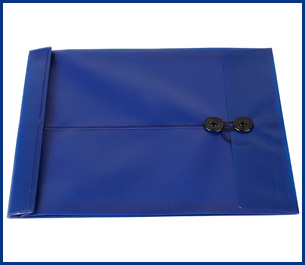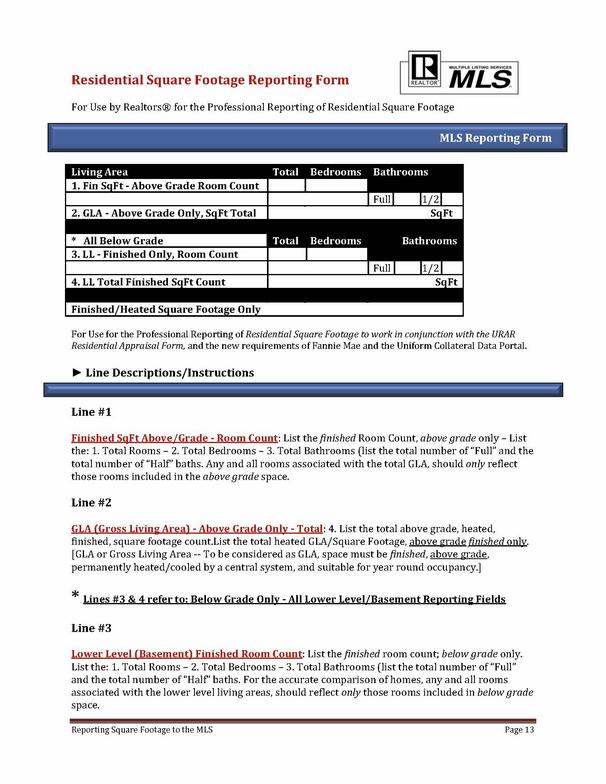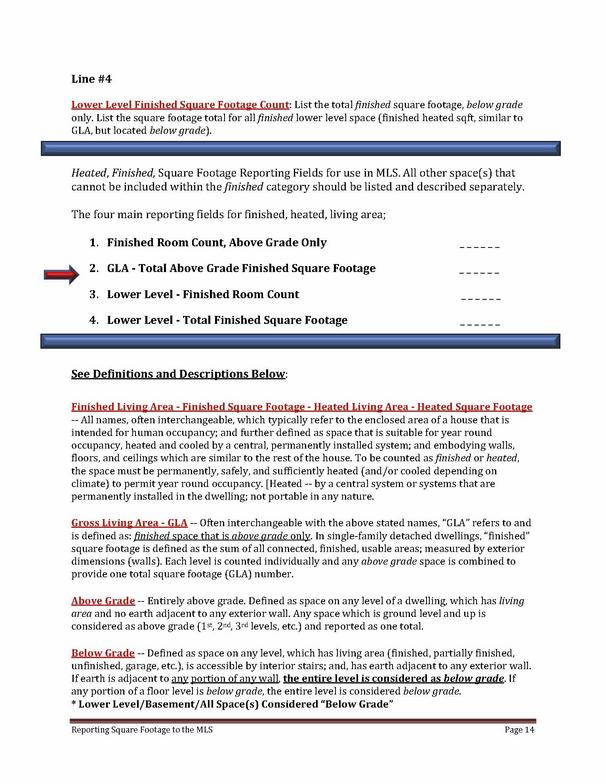New Square Footage Reporting Form for Agents & Appraisers
Residential Square Footage Reporting Form
Proposed Form For Use by Realtors® for the Professional Reporting of Residential Square Footage – to work with the new appraisal changes effective January 2013
The New Language of Residential Square Footage – Comparing “Apples to Apples”
Accurate CMA’s and appraisals require accurate square footage details; you can’t have one without the other. The MLS must go back to reporting detailed square footage information and its original purpose. That purpose was for Realtors® to provide accurate and complete property details for use by their peers in comparing and pricing real estate. Also, in order to provide consistently fair home valuations, agents and appraisers must use the same language of square footage. GLA (Gross Living Area) is a term used daily by appraisers and lenders, yet mostly unknown to brokers and agents. It is the term specifically designed for use in federally regulated mortgage transactions, to report and compare finished (above grade) living areas. It is a term that must be understood and utilized by all real estate professionals. The MLS is a truly unique organization and membership. Regardless of who provides it or where they get it, once any real property information is reported in the sold/closed MLS data, it instantaneously turns to “fact” and is consumed by numerous industries. It is “the most trusted source of real estate information in the world.”


What is the purpose of the MLS today?
The role of the MLS real estate information system needs to be redefined. The founding fathers of the MLS (in the early 1900’s) developed this database with a very clear purpose. The main function of their new creation was simple: to provide their members with quality information. The real estate professionals needed reliable data so they could accurately price real estate. There was a need for a shared source of information (often on handwritten index cards) that their peers could use to help them when comparing dwellings and determining home values (exclusively for use by MLS members). Pricing people’s single, largest, lifetime investment is a great responsibility and there had to be a better way of obtaining quality data. It was obvious (even in 1908) that the public records system was not a credible source for real estate information. The square footage data reported by county assessors was never designed or intended to be used outside the tax department. Thus, the Multiple Listing Service™ was founded.
From handwritten index cards up to the days of printed real estate books and quarterly “comp” books (available only to Realtor® members), the entire information network centered around providing quality property details for real estate professionals. Realtors® controlled the real estate market (and grew to the largest private trade organization in the world) because they controlled all the information.

* For over one-hundred years, the most valuable asset of the National Association of Realtors® and the MLS™ has been its information; accurate property information, created uniquely by and for its members.
Once the real estate market discovered the power of the internet, it was a mad dash to get this (once private) information out to everyone across the world. Bigger, shinier, more bells and whistles, and all created with one purpose; a new purpose. The objective of the new “online version” of the MLS is entirely different from the original MLS format.
Information, that was once created for use only by their peers, is now being created and distributed exclusively as advertising material to attract home buyers. It is available to anyone and everyone. These two, absolutely different functions, have caused a massive shift in the type and level of details reported for every home listed through the MLS. There is a wide disparity between a new listing entered into MLS as a snapshot of the home portrayed in its best light, to a listing entered to describe the property in sufficient detail to allow for fair comparisons with other similar homes. That shift in detail has jeopardized the quality of information and the reliability of the once exclusive members’ information network.
The new MLS is a marketing tool. It is no longer the private information source, where professionals share property details to help make them better at their jobs. The scope and level of consumer protection has changed with the purpose of the MLS. While home shoppers have access to more information than ever before, the quality of that information continues to decline at an alarming pace. In a poll reaching agents and appraisers in 42 states, over ninety percent thought that the information currently listed in MLS was unreliable. Wouldn’t it be nice if the MLS could combine the old and new; serving consumers (appraisers, lenders, and mortgage investors) better than ever before.
First Things First…
Realtors® and appraisers must be able to communicate in the same language of real estate. This new form is designed specifically for reporting residential square footage details, and allows agents and appraisers to employ the same terminology. When discussing residential square footage, all real estate professionals should be working on a level playing field. The use of this new form in MLS will dramatically improve the comparable data in MLS, and the quality of CMA’s, appraisals, appraisal management, appraisal underwriting, and mortgage security. Many industries will benefit from this modernization. In order for any improvement in MLS and square footage reporting, agents must also be able to disclose square footage details without the fear of liability. And, have a nationally approved and mandated square footage disclosure form (such as the form currently in use in Colorado). Consumers and real estate professionals will be better protected by the uniformity in square footage reporting. When buyers and sellers, agents and appraisers, assessors and adjusters, or anyone else discusses square footage and home values, they will all envision the same space.

Effective January 2013, square footage, and especially “below grade” information, will cause appraisals to come to a “hard stop” in the underwriting process. These issues will cause new delays and create a whole new group of low appraisals, based solely on square footage problems. Stay tuned. This problem will create a lot of attention over the next year as a new wave of low appraisals hits the market.
It’s time for GLA to hit the MLS…



